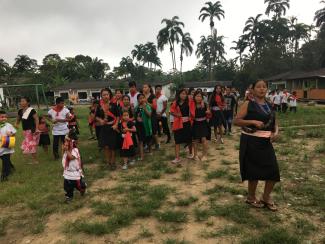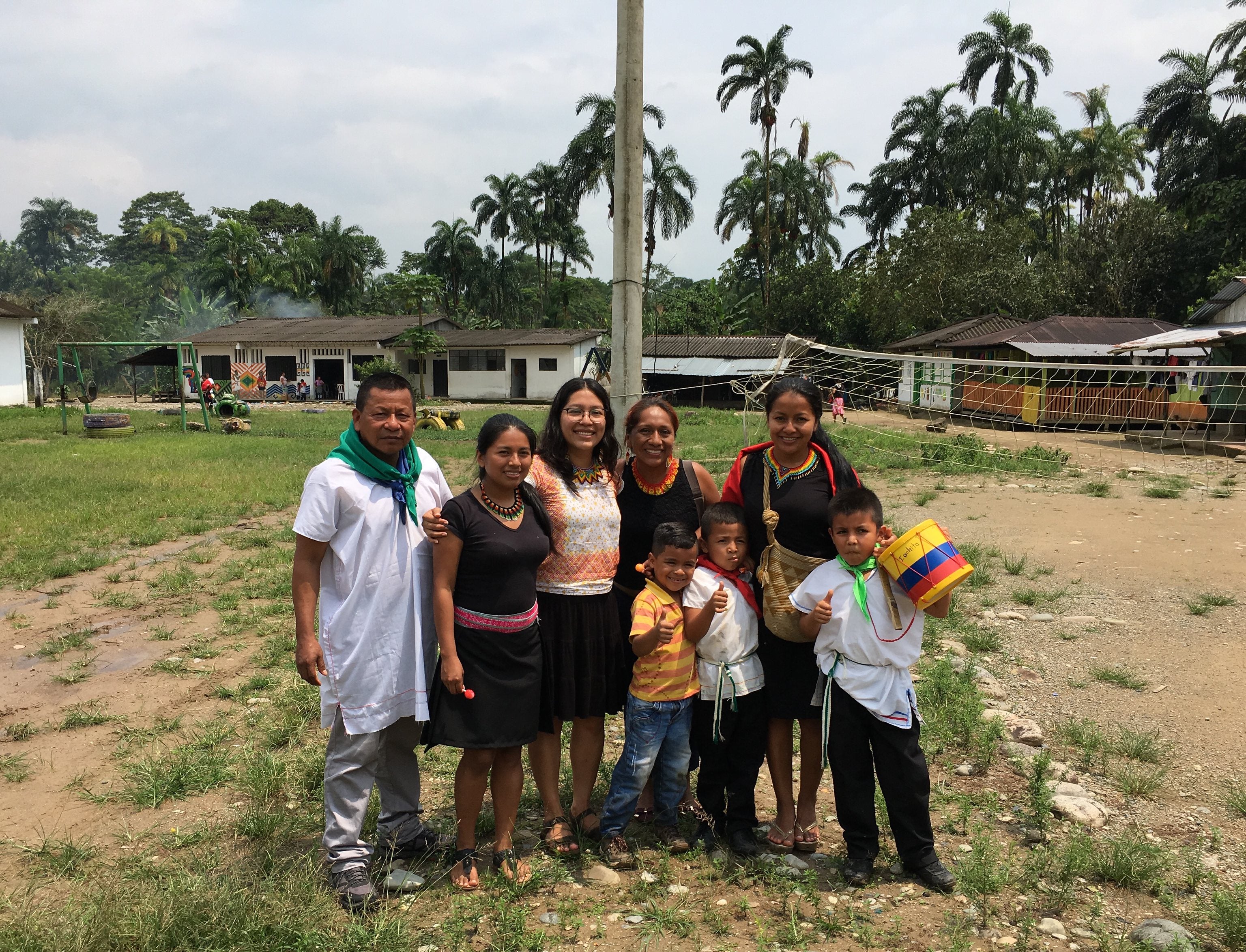
In the midst of the humble silence of the forests along the eastern mountain range of Colombia, it’s possible to hear the soft sound of children and young people singing. Though the words may be incomprehensible to most, the lyrics are a gift that represent resilience and honor. Singing in honor of Atun Puncha Day, a celebration that honors the fight for cultural resistance, perseverance, and strength, the children use a gift inherited from their Elders and families—a gift that was nearly lost and has since been revitalized— their language. For the Inga community of Colombia, communication is a power that holds not only their cosmology, history, and way of thinking, but also their identity. “Our language is beautiful,” Edna Viviana Papamija said. “It is the expression of who we are, how we live.”
Language endangerment is one of the greatest threats that many Indigenous communities face across the globe. In the face of the pressures of territorial losses, climate change, and globalization, language loss has only become more exacerbated as a result of these external forces. For the Inga, while 100 percent of their community identifies as Indigenous, only 50 percent of the population speaks the Inga language. Language is a cultural resource as valuable as any other natural resource under threat.
In the Putumayo of Colombia, the Resguardo Indígena San Miguel de la Castellana has formed an intergenerational collective to combat language loss through the revitalization of their language and cultural traditions. Through the efforts of their community and the support of Cultural Survival’s Keepers of the Earth Fund, the initiative has focused on four mingas de pensamiento (community gatherings of ceremonial exchange). Where “identity lies, history is told, narrated, and lived … the wisdom of the Elders is appreciated,” said Governor Aida Jacanamejoy, who is also known as la madre comunitaria. The four projects were established through a consensus among youth, linguists, and Elders. Their goal was to make the greatest impact possible in the community as they learned about traditional practices in the Inga language.

The first minga focused on the biodiversity of the Ingas’ ancestral lands. Participants learned about the arrangement of the tulpa (central fireplace) and its role in the preparation of native dishes. A variety of meals were prepared, including maitukusaska, a fish that is wrapped in sirindango leaf with natural seasonings and roasted on a charcoal grill. The minga provided students the opportunity to have a combined linguistic and cultural learning experience. Elders shared the significance of consuming natural food sources while teaching the youth participants the properties and characteristics that help one to avoid illnesses and prolong one’s lifespan.
The second minga was associated with the commemoration of Atun Puncha Day. Through phrases like ‘kausankamalla’ (as long as you live), participants recognized those who had fought before. Everyone wore crowns of feathers, traditional clothing, and necklaces of beans and natural seeds. The festivities were also joined by instruments like the bombo, rattle, and dulzaina. Meals of meat, yuca, and ají were served to accompany chicha, a traditional beverage made with either plantains, yuca, or chontaduro. United as a family alongside the governor, the Inga language was brought to life through songs and dances honoring nature, the Earth, and the cosmos.
The third minga was dedicated to sharing traditional games and songs with younger generations. Those who had the privilege to attend learned from Elder Enrique Jojoa, who told the story of the bodoquera, a weapon similar to a blowgun that was used to defend Inga territory against invaders. As he narrated, he presented one that he had inherited from his father. Dating nearly 150 years, it had remained intact. He talked about the significance of the phases of the moon in dictating how and when to properly cut the materials needed to manufacture the weapon, and the importance of geometry in measuring each piece needed. Elder Jojoa also showed how the connection between the essence of the Inga worldview and spirituality contains an abundance of play, hunting, and self-defense. His teachings showed the importance of appreciating the elders and also represented the cultural richness and wisdom held within Indigenous languages. Inspired by his story, the young participants set out to continue playing and building bodoqueras just as he, and the many that came before him, had done.

The fourth minga was focused on the theme of traditional medicine. Under the guidance of Taita Sinchi, a traditional Indigenous doctor known for his knowledge in ancestral medicine, participants took part in the ceremonial drinking of Yagé, or ayahuasca. Through the sacred ritual, they learned how to conduct the ceremony under the protection of the spirits of the land, arranging the necessary materials and leading the songs and music to create a space for others to focus on the healing process of the evening practice. Sinchi shared his story in traditional medicine and discussed the importance of frequently practicing the ceremony to fully understand the experience. By morning, each participant awoke with a renewed state of mind and body, followed by a cleansing process where Sinchi provided each person with advice regarding their professional, spiritual, and physical well being.
The mingas de pensamiento gave younger generations renewed gratitude in the traditional knowledge of their Elders and showed them the fundamental connections within their culture and maternal Inga language. Sandra Milena Buesaquillo, a young Inga girl, shared, “we still have time to strengthen our maternal language [and now] we have the support, wisdom, and the precious richness of our Elders.” Participants also developed an awareness for the ways in which their culture had been discriminated against and ways others had sought to dominate them through forced displacement and educational policies. In Colombia, the loss of territorial control and increase of criminal violence within Indigenous spaces has been associated with the increased likelihood of language endangerment. Members of the Inga community have borne witness to this with the rise of natural resource extractions on their lands.
Alongside the production of audio and written materials, including a book printed in the Inga language and the development of a kindergarten Inga school, the mingas de pensamiento have reconnected the community with their gift of voice and strengthened their spiritual connections. Through traditional activities, they have shared the history of the community and begun conserving their maternal Inga language. The practice of traditional foodways proved to be even more essential during the pandemic; women in leadership developed long term solutions that allowed the community to get closer to the land to cultivate their own food sources to achieve food sovereignty. Through the Inga language, present and future generations have the chance to capture the true meaning and significance of their cultural traditions.
Keepers of the Earth Fund (KOEF) is an Indigenous Led Fund within Cultural Survival designed to support Indigenous Peoples’ community development and advocacy projects. Since 2017, through small grants and technical assistance, KOEF has supported 182 projects in 36 countries totaling $791,838. KOEF provides, on average, $5,000 grants to grassroots Indigenous-led communities, organizations, and traditional governments to support their self-determined development projects based on their Indigenous values. Predicated on the United Nations Declaration on the Rights of Indigenous Peoples, Cultural Survival uses a rights-based approach in our grantmaking strategies to support grassroots Indigenous solutions through the equitable distribution of resources to Indigenous communities. In 2020, a COVID-19 emergency KOEF grant also supported Resguardo Indígena Inga San Miguel de la Castellana’s efforts to develop a longterm solution project to ensure food sovereignty, which strengthened their connection to their lands.
All photos courtesy of Bia’ni Madsa’ Juárez López. Bia’ni Madsa’ Juárez López (Ayuuk ja’ay and Binnizá), Keepers of the Earth Fund Program Manager, with teachers, students, and members of the San Miguel de la Catellana community.
